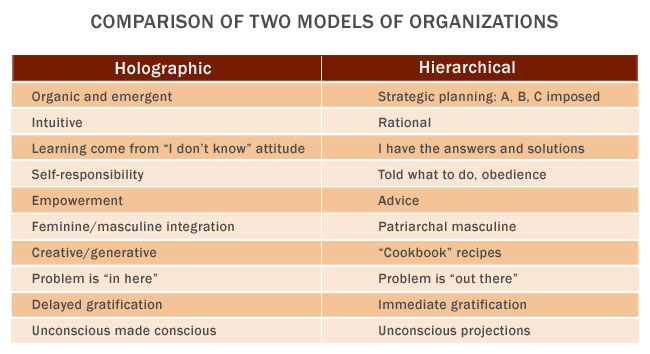Holographic Organizations: An Introduction
Holographic Organizations:
An Introduction
We articulate a purpose, vision, and mission
so it can be expressed in all aspects of the organization. In this sense, a group's
philosophy is holographic.
Within the holographic model, what is true for the individual member is reflected in the organization.
What is a hologram?
If you turn a photograph over, you see a blank white surface. A photograph shows the image only from the front, thus from only one side. A hologram is a three-dimensional image created by interacting light sources. It shows the same image from all angles, regardless of how it is being viewed.
When a hologram is divided into pieces, each part still contains the entire image within it, although each new image is from a slightly different perspective.
How does the concept of the hologram apply to organizational structures?
When people come together to share a vision for an organization, each person has his or her own unique perspective of the whole organization. Each shares responsibility for the whole, not just her or his piece. But the component pieces are not identical. Each presents the whole picture from a different point of view.
When we add up the pieces of the hologram, the image of the whole does not change fundamentally, but rather the image becomes more intense. When more people share the common vision, the vision may not change fundamentally but it becomes more alive, more real in the sense of a mental reality that people can truly imagine achieving.
When more people share
the common vision, the
vision may not change fundamentally but it
becomes more alive.
How can an organization's philosophy be holographic?
Within the holographic model, what is true for the individual member is reflected in the organization. What we as individuals bring to the organization – in the way of our perceptions, assumption, beliefs, values, and attitudes – interacts and affects the direction and future capacity of the organization.
In a holographic model, an organizational philosophy and accompanying structures that support the growth of the individual and the group will support parallel growth in the organization. We articulate a purpose, vision, and mission so that it can be expressed in all aspects of the organization. In this sense, a philosophy is holographic.
What do we need to be mindful of when working with the holographic model?
In the holographic model, we need to be aware:
- of the whole with the parts, their interrelationships, and the context
- that one part of the organization (i.e., any specific program or activity) reflects the philosophy of the whole of the organization
- that members of the organization reflect the whole of the organization in their behavior and work responsibilities
- that each member’s perspective of the vision is unique and relates to the whole

Why do we need both holographic and hierarchical models?
We need the strengths of both models because we get into trouble when we move into “either/or” thinking. We need to incorporate appropriate elements from both models at the appropriate times. Sustainable change will be gradual.
Reference: Leadership and Organizational Training, Institute for the Advancement of Service, 2009.
![]()
This website, designed by the Institute for the Advancement of Service and representing the psychological-spiritual books, courses, teachings, and practices it developed over its 45 years as a nonprofit organization (1980-2025), is not intended to provide medical or mental health care. The books, courses, teachings, and practices represented on this website do not provide psychotherapy, medical therapy, or a substitute for either one. Users of this website are expected to assume self-responsibility for their wellbeing by seeking, when appropriate, psychological and medical professional services.
Every good-faith effort has been made to document accurately any reference material and citations used throughout this website.
Copyright © 2025 by Susan S. Trout. You are free to share selections from this website for noncommercial purposes if you attribute what you share to the Institute for the Advancement of Service and Susan S. Trout. You may summarize the material on this website provided you accredit it to the Institute for the Advancement of Service and Susan S. Trout and do not alter its meaning.







